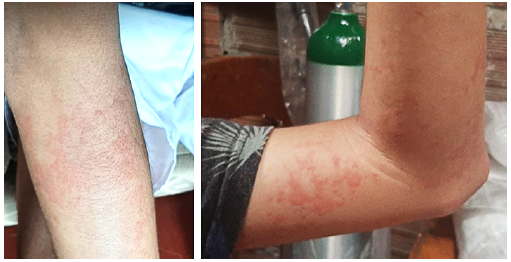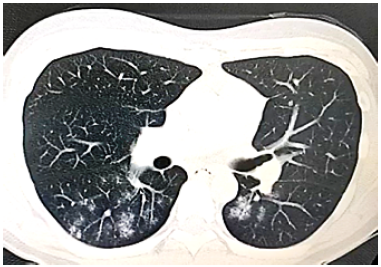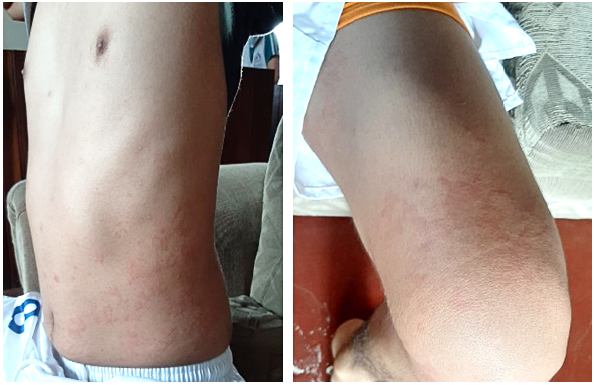Introduction
COVID-19 is the disease caused by the SARS-CoV-2 virus. It was first described in Wuhan, China, in December 2019, and has since rapidly spread worldwide, affecting more than 60 million people. In this regard, COVID-19 has become a health problem that has dramatically and negatively impacted health systems, especially in Latin American countries where facilities and service delivery are often deficient.1-3
The clinical characteristics of COVID-19 are variable, depend on the severity of the disease, and may range from an asymptomatic state to severe conditions in which complications such as respiratory distress and multiple organ failure occur. Even though the most common manifestations are respiratory, other extrapulmonary manifestations such as neurological, digestive, and dermatological conditions have also been reported.2,4 This variability can be explained because SARS-CoV-2 enters cells through angiotensin-converting enzyme 2 receptors, which are found in various organs such as lungs, heart, brain, testicles, blood vessels, and even skin.5
Several studies on COVID-19 have been conducted in Peru, but, to date, no cases of skin manifestations related to this disease have been reported in the Peruvian population. This becomes important because there are environments in the country where viral diseases that produce similar dermatological manifestations coexist, as is the Peruvian jungle. This article reports the case of a patient diagnosed with COVID-19 and associated skin manifestations who was treated in a hospital in the Peruvian jungle.
Case presentation
A 16-year-old male patient with no relevant medical history was admitted to the emergency department of the Hospital Amazónico in Pucallpa, Peru, on April 28, 2020. The patient had experienced headache, cough, myalgia, malaise, hyposmia, and hypogeusia for 5 days. On admission, he had diarrhea (four stools per day without mucus or blood) and reported chills and respiratory distress.
Physical examination findings were heart rate of 154 bpm, respiratory rate of 32 brpm, blood pressure of 90/70 mmHg, oxygen saturation of 89-90%, and axillary temperature of 38°C. Also, slight bilateral decrease in vesicular breath sounds were found, as well as a skin rash characterized by non-evanescent, confluent, pruriginous, and symmetrical erythematous papules in limbs, abdomen, chest, and face, with no mucosal involvement (Figure 1). Laboratory results taken on admission showed positive serological tests for SARS-CoV-2 (IgM+ and IgG+), C-reactive protein at 4.2 mg/dl and negative dengue ELISA test.

Source: Document obtained during the study.
Figure 1 Morbilliform lesions in upper limbs in a patient with COVID-19.
Figure 2 shows the result of the non-contrast chest CT scan performed on the patient, where ground-glass opacities associated with interstitial thickening of patchy distribution were found predominantly in the posterior basal segment of both lung fields. This was consistent with viral atypical pneumonia and confirmed the presence of COVID-19.

Source: Document obtained during the study.
Figure 2 Non-contrast chest CT scan showing lesions consistent with COVID-19 atypical pneumonia.
The diagnosis of COVID-19, in this case, was confirmed based on clinical, serological, and radiological parameters since molecular tests are usually scarce in the Hospital Amazónico.
The patient received initial treatment in the Emergency COVID Unit within the first 24 hours and was subsequently hospitalized in the COVID Medicine Service, where he was administered 2g of intravenous ceftriaxone every 24 hours, 500mg of oral azithromycin every 24 hours, 8mg of intravenous dexamethasone every 24 hours, 5mg cetirizine every 12 hours, and binasal cannula oxygen therapy at an inspired oxygen fraction of 32%. No biopsy of skin lesions was performed. On the fifth hospitalization day, and in view of the persistence of respiratory and cutaneous symptoms, oral treatment was initiated with a single dose of 50 drops of ivermectin (6 mg/mL); 48 hours after administering this medicine, the skin rash improved (Figure 3).

Source: Document obtained during the study.
Figure 3 Improvement of skin lesions after 24 hours of ivermectin treatment in a patient with COVID-19.
Finally, the patient was discharged with clinical improvement eight days after being admitted to the emergency room.
Discussion
At first, COVID-19 was described as a respiratory disease that caused atypical pneumonia, whose main symptoms were fever, cough, and myalgia.2 However, other neurological (hyposmia, hypogeusia), gastrointestinal (nausea, vomiting, diarrhea, abdominal pain)6,7 and dermatological4 symptoms were subsequently reported; the latter were observed in the reported patient.
COVID-19 is diagnosed based on symptoms and results of imaging studies and reverse-transcription polymerase chain reaction (RT-PCR) test for SARS-CoV-2. However, the RT-PCR test, in the present case, was replaced by the detection of IgG and IgM against SARS-CoV-2 through a rapid test, which is readily available in Peru.8 It should be noted that, in Peru, due to their high diagnostic performance, serological tests are used to complement molecular tests from the second to the third week of illness to improve diagnosis. This is important for public health because it allows identifying new affected geographical areas and recording a greater number of severe cases and deaths from COVID-19.9 In addition, the diagnostic performance of serologic tests to detect COVID-19 increases when used along with chest CT scan.10
Galván-Casa et al.,11 in a review of 375 cases, classified dermatological lesions in patients with COVID-19 into five groups: maculopapular rash (47%), acral areas of erythema with vesicles or pustules (19%), urticaria lesions (19%), other vesicular eruptions (9%), and livedo or necrosis (6%). Likewise, Recalcati12 found that 20.4% of the studied population had erythematous rash, generalized urticaria, and chickenpox rash. In both studies, rash and maculopapular lesions were reported as the most frequent manifestations, which coincided with this case, where the patient presented morbiliform lesions.
Maculopapular lesions can easily be confused with exantematic and metaxenic diseases, which are typical of tropical regions. Therefore, it is worth noting that clinical characteristics of dengue,13 zika and chikungunya are very similar to those of COVID-19 (fever, maculopapular rash, and lymphopenia.)13,14 Since these diseases are endemic to the Peruvian jungle, it is important to consider them when diagnosing COVID-19.
Some research has found that urticaria and maculopapular lesions in COVID-19 patients have a resolution period between 6 and 8 days and appear on par with the other symptoms,11 as in the present case. Recalcati12 reported that there is no correlation between skin manifestations and disease severity.
The mechanism by which SARS-CoV-2 causes skin lesions is still unknown; however, Sachdeva et al.15 have proposed, based on the report of three cases and a literature review, that the virus triggers a vasculitis that releases cytokines and attacks keratinocytes after Lang-erhans cells activation, which affects the epidermis.
According to the National Technical Standard of the Ministry of Health of Peru,16 the present case of COVID-19 was classified as moderate-severe. The patient received oxygen therapy, azithromycin, corticosteroids, and antihistamines; the latter were ineffective to treat pruritus. In this context, it should be considered that skin lesions might be secondary to adverse drug reactions, so the treating physician should always monitor treatment.
It is also important to mention that the patient received ivermectin, an antiparasitic with a known safety profile. However, its use remains controversial after Cary et al.17 demonstrated that it could inhibit SARS-CoV-2 replication in vitro in early April 2020, although this effect has not yet been demonstrated in vivo, as very high doses would be needed to achieve the same effect in humans. Therefore, it is not possible to establish a relationship between the patient's clinical improvement and the use of ivermectin. In Peru, the Ministry of Health has included in its regulations this drug to treat all confirmed cases of COVID-19,16 but this standard indicates that there are no specific treatments supported by clinical trials and that the treating physician must request the patient's informed consent before starting any treatment and monitor their progress.
Conclusion
COVID-19 is a disease that can manifest with skin lesions similar to those produced by other viruses (dengue, zika, chikungunya) and adverse drug reactions. Therefore, to make an appropriate diagnosis, especially when molecular tests are not available, it is necessary to conduct an adequate patient interview, establish the chronological order of symptom onset, and take advantage of serological and radiological criteria, which are usually available in isolated areas such as the Peruvian jungle. Moreover, it should be noted that the use of oral ivermectin may generate beneficial effects in patients with COVID-19, but further research is needed to corroborate this hypothesis.















